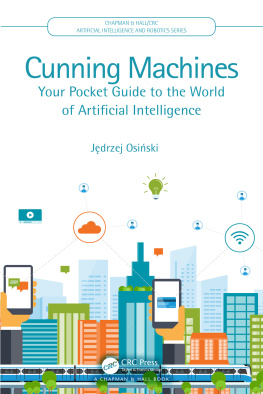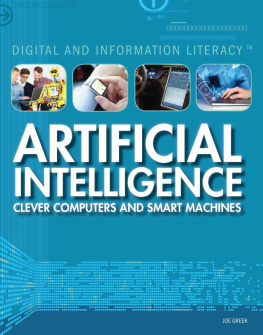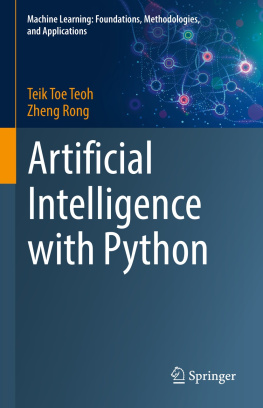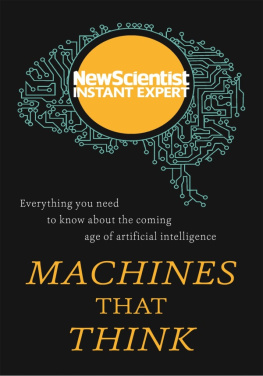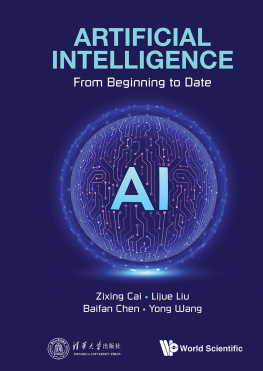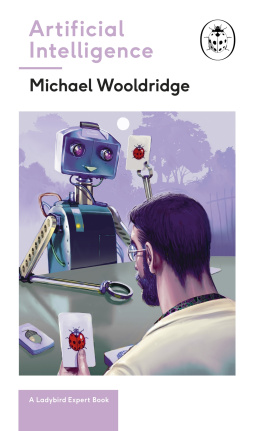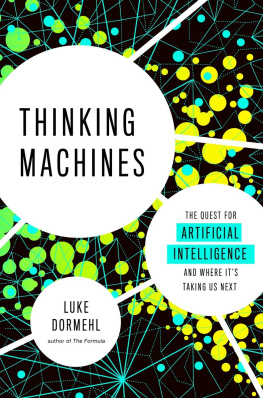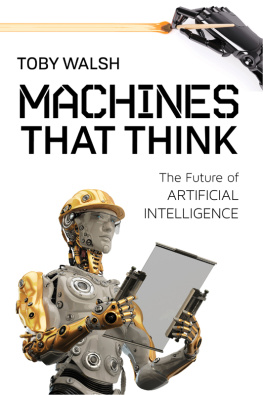Cunning Machines
Chapman & Hall/CRC Artificial Intelligence and Robotics Series
Series Editor: Roman Yampolskiy
Intelligent Autonomy of UAVs
Advanced Missions and Future Use
Yasmina Bestaoui Sebbane
Artificial Intelligence
With an Introduction to Machine Learning, Second Edition
Richard E. Neapolitan, Xia Jiang
Artificial Intelligence and the Two Singularities
Calum Chace
Behavior Trees in Robotics and Al
An Introduction
Michele Collendanchise, Petter gren
Artificial Intelligence Safety and Security
Roman V. Yampolskiy
Artificial Intelligence for Autonomous Networks
Mazin Gilbert
Virtual Humans
David Burden, Maggi Savin-Baden
Deep Neural Networks
WASD Neuronet Models, Algorithms, and Applications
Yunong Zhang, Dechao Chen, Chengxu Ye
Introduction to Self-Driving Vehicle Technology
Hanky Sjafrie
Digital Afterlife
Death Matters in a Digital Age
Maggi Savin-Baden, Victoria Mason-Robbie
Multi-UAV Planning and Task Allocation
Yasmina Bestaoui Sebbane
Cunning Machines
Your Pocket Guide to the World of Artificial Intelligence
Jdrzej Osiski
For more information about this series please visit:
https://www.crcpress.com/Chapman--HallCRC-Artificial-Intelligence-and-Robotics-Series/book-series/ARTILRO
To my lovely wife Monika,
Who is so charming, spontaneous and full of empathy
that could never be replaced by AI,
And to my wonderful son Kacper,
Whose never-ending questions
keep my neurons active seven days a week.
If you cant explain something simply,
you dont understand it well enough.
ALBERT EINSTEIN
Cunning Machines
Your Pocket Guide to the World of Artificial Intelligence
Jdrzej Osiski

First edition published 2020
by CRC Press
6000 Broken Sound Parkway NW, Suite 300, Boca Raton, FL 33487-2742
and by CRC Press
2 Park Square, Milton Park, Abingdon, Oxon, OX14 4RN
2020 Taylor & Francis Group, LLC
CRC Press is an imprint of Taylor & Francis Group, LLC
Reasonable efforts have been made to publish reliable data and information, but the author and publisher cannot assume responsibility for the validity of all materials or the consequences of their use. The authors and publishers have attempted to trace the copyright holders of all material reproduced in this publication and apologize to copyright holders if permission to publish in this form has not been obtained. If any copyright material has not been acknowledged please write and let us know so we may rectify in any future reprint.
Except as permitted under U.S. Copyright Law, no part of this book may be reprinted, reproduced, transmitted, or utilized in any form by any electronic, mechanical, or other means, now known or hereafter invented, including photocopying, microfilming, and recording, or in any information storage or retrieval system, without written permission from the publishers.
For permission to photocopy or use material electronically from this work, access
Trademark notice : Product or corporate names may be trademarks or registered trademarks, and are used only for identification and explanation without intent to infringe.
ISBN: 978-0-367-89861-8 (hbk)
ISBN: 978-0-367-89802-1 (pbk)
ISBN: 978-1-003-02153-7 (ebk)
Typeset in Minion
by Deanta Global Publishing Services, Chennai, India
Contents
BEFORE GOING ANY FURTHER, here is the one sentence I truly believe in and I want to ask you to keep in your mind from now on: everyone can be a scientist. I would say, even stronger: everyone is a scientist.
Looking back at the history of our civilisation, we sooner or later realise that nobody has ever been born or educated to be a world-changing scientist or inventor. Pierre de Fermat, a seventeenth-century genius whose results have been influencing mathematicians for generations, was earning his living as a lawyer. Albert Einstein revolutionised the whole field of physics while working as a clerk in a patent office.
The problem is that nowadays people are discouraged from science. When Einsteins theories were experimentally confirmed, he became a celebrity more recognised than music stars. World-renowned newspapers announced contests to describe the theory of relativity in the simplest possible form. And there were thousands of participants people of many different professions, not only physicists. The world was truly interested in the topic. Today there are more discoveries made every year than there were during whole decades in the previous century. But we do not see them. Or do not want to see. Or do not have time for it. Why?
The first reason is the rush. Being in a hurry is simply trendy. Unfortunately, the same happens in school and in the workplace. I have heard it many times as an academic teacher: I wont need that. I just want to learn the things I will use at work. And that is the beginning of the end. The end of creativity. The knowledge people which are taught is more and more limited, focusing only on specific tasks. From bright, thinking beings we are slowly changed into tools. People start to avoid theories and learn only their applications. There is no time for understanding the concept we have just enough to employ the solution we have been shown. Having no time to ask why , we are left only with how .
The second reason is one of the biggest lies being successfully repeated everywhere to younger and younger people. They are told they will be unable to understand something. Some are said to be humanists , so they should not even try to look at a mathematical equation (as they could go blind from it). People are somehow classified after the first attempt at something. Did you know that Einsteins first version of his PhD dissertation was rejected? Or that for over two years he was unsuccessfully looking for employment as a teacher? What would he be told nowadays? Probably something like: Leave it. Just learn to use this software. Companies need people that know that. And they pay well.
Do not give up knowledge. Do not look at visible benefits. Do not resign if your boss tells you it is not required. Contact with science does not only develop your skills but, much more importantly, it develops your mind. If you teach your brain to avoid challenges, you will sooner or later stand in front of a situation in which you have absolutely no idea what to do. A void in your head. Simply teach yourself to be interested in the world. Leave your work procedures and standards for a second and look at your work as a spectator. Stand for a moment on a street and think about the material it is made of.
And the great thing is you dont need to learn to be creative. You just need to remind yourself of how it is to be creative. Kids are very creative and ask thousands of questions. It is just the case that as they grow older, they are told that they will not need all the answers.
Never stop asking questions. Curiosity is one of our strongest instincts. Do not fight it, treat it a gift. Learn and be proud of it, despite your age. A scientific view may help you to find solutions at work and in your personal life. Curiosity keeps your mind active and prevents dementia.
Do not believe anybody who says you are unable to understand something. We are all born with the same curiosity in our minds and hearts. Follow it. Everyone is a scientist.

